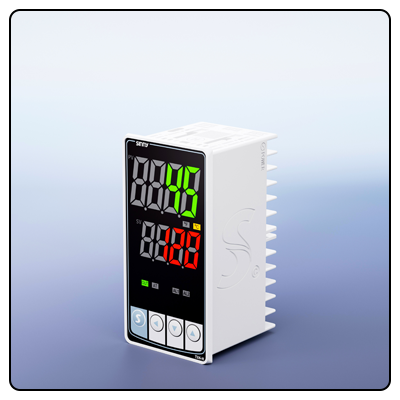Understanding the Different Modes of Temperature Control: A Comprehensive Guide
Discover various modes of temperature control, such as On/Off, Proportional PID Adaptive Fuzzy Logic Control. Discover how these controls enhance efficiency while decreasing costs and improving product quality across diverse industries.
1. Introduction
Temperature controllers are essential tools used across industries to maintain accurate temperature levels. An understanding of all of the various modes of temperature regulation is vital when choosing an ideal controller for specific uses; in this article we cover these various forms, their benefits, and applications in various sectors.
2. Definition and Function of Temperature Control
The definition and purpose of temperature control involves maintaining an ideal set point temperature within any system or process by monitoring actual temperatures versus setpoint, making adjustments as needed, and monitoring their progress towards compliance.
Key Components of Temperature Control Systems: Sensors, Controllers and Actuators make up the primary components of temperature control systems. Sensors monitor actual temperatures; controllers then process that information and make any required changes; while actuators then implement changes necessary to achieve desired temperatures.
3. Types of Temperature Control Modes
On/Off Control is the simplest type of temperature regulation. It works by switching output on or off when temperature levels reach a setpoint - cost-effective yet simple implementation, though may lead to fluctuations around that mark.
Proportional Control: Proportional control constantly adjusts output based on any difference between its set point and actual temperature, providing more stable temperature control by decreasing overshoot or undershoot risk and creating smoother adjustments through proportional output that responds directly to temperature deviations.
PID Control: PID (Proportional-Integral-Derivative) control uses proportional control in combination with integral and derivative actions to provide precise temperature regulation. Proportional component addresses current error while integral corrects past ones while derivative anticipates any further deviations - creating highly accurate yet stable temperature regulation.
Adaptive Control Algorithms: Temperature controllers equipped with adaptive control algorithms automatically adapt their parameters in response to changing conditions, providing optimal performance and stability even in dynamic environments. Adaptive control is particularly advantageous in applications where process conditions vary frequently.
Fuzzy Logic Control: Fuzzy logic controllers use fuzzy logic to deal with uncertain or imprecise information to provide more effective temperature regulation in complex systems where traditional control methods don't perform optimally. By making decisions based on approximate data sets, fuzzy logic controllers offer robust yet flexible temperature regulation solutions.
3. Open Loop Vs Closed Loop Control
Open loop control is a basic form of regulation without feedback loops that sends predetermined output to actuators regardless of temperature changes in real time. This mode works best in applications where precise temperature regulation is not essential.
Closed Loop Control (also referred to as feedback control) utilizes input from sensors in order to maintain an ideal temperature environment. A controller constantly compares actual and set point temperatures and makes adjustments accordingly - thus offering more precise regulation than its alternatives. Providing accurate temperature regulation makes Closed Loop Control ideal for applications which demand precise regulation.
4. Industry-Specific Applications
Manufacturing: Temperature control is vital to manufacturing quality products. Temperature controllers can help keep product temperatures consistent throughout processes like plastic molding, metal treatment and electronics production reducing defects while improving productivity and enhancing efficiencies.
Food & Beverage: Temperature regulation in the food and beverage industries is of critical importance in order to guarantee food safety and quality. Temperature controllers play a vital role in pasteurization, fermentation, refrigeration and storage operations - helping keep temperatures within their specified parameters to prevent spoilage as well as ensure compliance with safety standards.
Pharmaceuticals: Temperature control is vitally important to maintaining efficacy and safety within the pharmaceutical industry. Temperature controllers are utilized during drug manufacturing, storage and transportation processes ensuring optimal conditions are created to preserve sensitive drugs' integrity and efficacy.
HVAC Systems: Temperature controllers help increase energy efficiency and comfort in residential and commercial properties by maintaining precise temperature settings at precise times of the year. By doing so, they help optimize energy use as well as enhance indoor air quality for an enjoyable indoor atmosphere.
5. Advanced Features and Technologies
Remote Monitoring and Control: Thanks to IoT and cloud-based systems, modern temperature controllers can now be monitored remotely so users can make real-time adjustments or track performance from any locati0n - improving convenience and efficiencies alike.
Data Logging and Analysis: Advanced temperature controllers offer advanced temperature data logging features for detailed analysis and process improvement, making these controllers ideal for tracking trends, diagnosing issues, or optimizing processes over time. This feature can help identify patterns quickly while optimizing processes to address them more quickly.
Self-Tuning and Auto-Tuning: Temperature controllers with these features allow them to automatically tune their settings for optimum performance, learning from experience to make necessary changes and making needed modifications, while auto-tuning controllers quickly set optimal parameters during initial setup.
6. Benefits of Understanding Different Modes
Understanding Different Modes Achieve Improved Efficiency: Learning about different temperature control modes enables individuals to select the appropriate one for specific applications, thus increasing efficiency and improving performance.
Cost Savings: Optimizing temperature control reduces both energy use and operational expenses, leading to significant cost-cutting measures and savings for businesses. By choosing an appropriate mode, businesses may experience considerable cost-savings benefits.
Enhance Product Quality: Precise temperature controls result in improved product outcomes, helping ensure high-quality goods with reduced defects and waste. Temperature controllers play a critical role here by maintaining steady temperatures across a product's lifespan and helping ensure consistent temperature readings are applied by manufacturing facilities.
7. Conclusion
Knowledge of different modes of temperature control is integral for selecting an effective thermostat for various industries and applications. By considering industry specific needs and taking advantage of various control modes, businesses can achieve enhanced efficiencies, cost reductions and product quality enhancement. Consulting experts or taking advantage of advanced features may further optimize temperature management to achieve operational excellence and ensure success.
- Discover the uncomprehension of Industrial Temperature Controllers
- The Importance of Temperature Controllers in Research and Development























